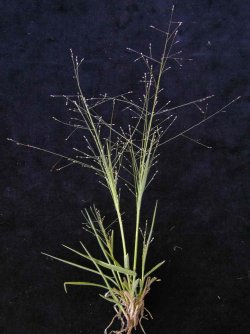
Hairy panic
SCIENTIFIC NAME: Panicum effusum
CATEGORY: C4 perennial
IDENTIFICATION TIPS
- A tufted, warm season, generally short-lived, perennial to 0.5m high
- Leaves, leaf sheaths and nodes are hairy
- Leaves are dull green, with distinctive long glandular hairs along the leaf margins
- Seedhead is an open panicle, with spikelets commonly paired
- Germinates in spring and flowers in summer and autumn
CLIMATIC & SOIL REQUIREMENTS
- Found at low to moderate abundance in native pastures, woodlands or disturbed areas (e.g. roadsides) in full sun
- Most common on sandy or shallow, low fertility soils
- Highly drought tolerant, but sensitive to frost
GRAZING & NUTRITIONAL VALUE
- Moderate to high grazing value
- Digestibility ranges from 53-71%
- Crude protein 12.4-20%
MANAGEMENT STRATEGIES
- Capable of quickly responding to small rainfall events, it is a low yielding grass that provides a palatable and high quality feed up until flowering; mature forage is of reasonable quality
- Can cause photosensitisation (blistering of hairless or light-coloured areas) if eaten in large quantities or as a major proportion of the animals diet within 2-6 weeks after rain.
- Seedheads are often windblown, piling up against fence-lines
Modified 11 April 2007Doesn’t respond to increased soil fertility and tends to be out competed when fertiliser is applied
- Best suited to light grazing pressure
- Not very tolerant of heavy grazing, but persists if rested during flowering as it seeds well and regenerates rapidly
SIMILAR PLANTS
- There are a number of other Panicum species, especially in the west of the area, but none have long glandular hairs along the edges of their leaves
- Native millet (Panicum decompositum) forms a large blue-green tussock and the leaves have a distinct whitish midvein. It is an occasional species in open areas, usually on heavier soils

Hairy Panic (Panicum effsum). Photo: H. Rose

